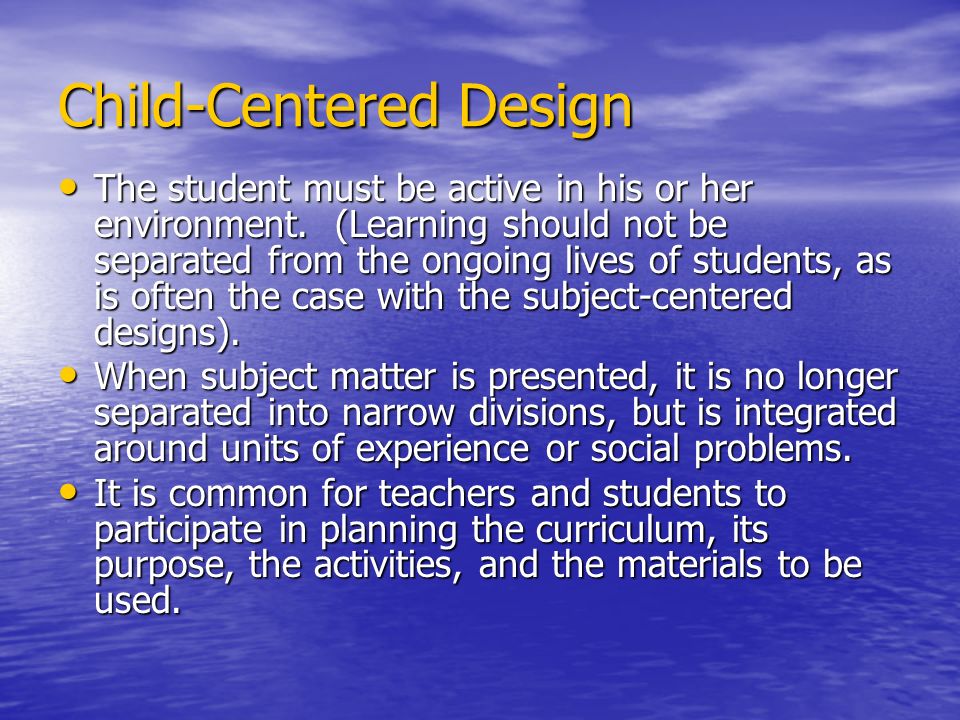
Tailoring Education: The Essence of Child-Centered Curriculum Design
In the realm of education, the concept of child-centered curriculum design has emerged as a guiding principle, prioritizing the individual needs, interests, and developmental pace of each learner. This exploration delves into the significance of child-centered curriculum design, its impact on student engagement, and the transformative potential it holds for education.
Understanding Child-Centered Curriculum Design
Child-centered curriculum design revolves around placing the child at the heart of the educational process. It recognizes that learners are unique individuals with distinct learning styles, interests, and capabilities. This approach aims to create a curriculum that adapts to the diverse needs of students, fostering a more meaningful and personalized learning experience.
Personalized Learning Paths: Nurturing Individuality
At the core of child-centered curriculum design is the idea of personalized learning paths. This involves tailoring educational experiences to match each student’s strengths, preferences, and pace of learning. By acknowledging and accommodating individual differences, educators can create an environment where every learner feels seen, valued, and supported.
Cultivating Intrinsic Motivation: Igniting Passion for Learning
Child-centered curriculum design seeks to cultivate intrinsic motivation in students. By aligning educational content with their interests and providing opportunities for exploration, students are more likely to develop a genuine passion for learning. This intrinsic motivation becomes a powerful driving force, fueling curiosity and a desire for knowledge.
Flexibility and Adaptability: Dynamic Curriculum Evolution
One hallmark of child-centered curriculum design is its flexibility and adaptability. The curriculum is not a static entity but evolves based on ongoing assessments of student needs and progress. This dynamic approach allows educators to make real-time adjustments, ensuring that the curriculum remains responsive and relevant to the changing dynamics of the classroom.
Active Student Participation: A Shift in the Learning Dynamic
In a child-centered curriculum, students take an active role in their learning journey. This shift in the learning dynamic transforms students from passive recipients to engaged participants. They are encouraged to ask questions, explore topics of interest, and contribute to the direction of their learning, fostering a sense of ownership and responsibility.
Holistic Development: Beyond Academic Achievement
Child-centered curriculum design embraces the holistic development of students. It recognizes that education goes beyond academic achievement and includes social, emotional, and physical growth. Integrating diverse learning experiences, such as collaborative projects, hands-on activities, and opportunities for creativity, contributes to a well-rounded and resilient individual.
Inclusive Learning Environments: Embracing Diversity
An inherent aspect of child-centered curriculum design is the emphasis on creating inclusive learning environments. The curriculum considers and celebrates the diversity of students, acknowledging various learning styles, cultural backgrounds, and abilities. This inclusivity fosters a sense of belonging and promotes positive peer relationships.
Educator as Facilitator: Guiding the Learning Journey
In child-centered curriculum design, educators transition into the role of facilitators. Instead of delivering content in a one-size-fits-all manner, they guide students through their learning journey. Facilitators observe, assess, and provide support as needed, fostering a collaborative relationship that empowers students to take an active role in their education.
Child-Centered Curriculum Design: A Catalyst for Lifelong Learning
For those interested in exploring and implementing child-centered curriculum design, Child-Centered Curriculum Design serves as a valuable resource. This platform offers insights, courses, and practical tools designed to support educators, parents, and anyone passionate about fostering a child-centered approach to learning. Explore the link between child-centered curriculum design and the transformative impact it can have on educational practices.
Conclusion: Shaping Future Leaders through Personalized Education
In conclusion, child-centered curriculum design is a catalyst for shaping future leaders and lifelong learners. By tailoring education to the unique needs and interests of each student, this approach unlocks their potential, ignites a love for learning, and prepares them for a dynamic and ever-changing world. Embrace the philosophy of child-centered curriculum design, and pave the way for a more personalized, engaging, and impactful educational experience.





